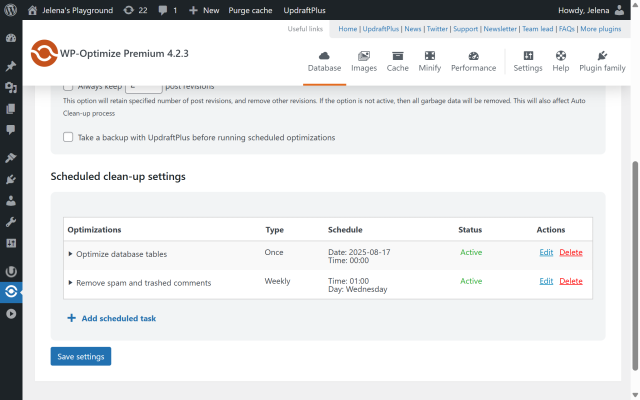How to clean up and optimize your WordPress database
Over time, your WordPress site quietly collects digital “junk” – old post revisions you’ll never use, spam comments, orphaned data from deleted plugins, and expired temporary records. This invisible clutter sits in your database, slowing down page loads, making backups take longer and leaving your admin dashboard feeling just a little sluggish.
The tricky part? Cleaning it up manually often means diving into complex SQL commands or poking around in phpMyAdmin, tasks most site owners either don’t have time for or would rather avoid altogether. Meanwhile, the clutter just keeps growing, making your site less responsive day by day.
That’s where WP-Optimize comes in. This all-in-one tool safely clears out the unnecessary data, reorganizes your database, and even adds extra speed boosts through image compression and caching. All in just a few clicks, no technical skills required.
In this guide, you’ll discover exactly how to use WP-Optimize for quick, effective database cleanup, plus a few smart habits to keep your site lean in the long run. And for those who like exploring options, we’ll also share some alternative plugins at the end.
Why WP-Optimize is the best choice for database cleanup
Section titled Why WP-Optimize is the best choice for database cleanupWP-Optimize stands out because it combines database cleanup, image compression and page caching in one plugin. For database optimization specifically, it can:
- Remove old post revisions, trashed posts and spam comments
- Clean expired transients and orphaned metadata
- Optimize tables to reduce overhead and fragmentation
- Schedule recurring cleanups so your database stays in shape
How to clean and optimize your WordPress database with WP-Optimize
Section titled How to clean and optimize your WordPress database with WP-Optimize1. Back up your site first
Section titled 1. Back up your site firstEven though WP-Optimize is safe, a backup is your insurance policy.
If you have UpdraftPlus installed, you don’t even need to leave WP-Optimize to take one. On the Database tab in WP-Optimize, you’ll see a “Take a backup with UpdraftPlus before doing this” checkbox right above the cleanup options.
Clicking this creates a complete backup of your site before you run any optimization. This means you can restore instantly if anything unexpected happens during the cleanup.
2. Install and activate WP-Optimize
Section titled 2. Install and activate WP-Optimize- Go to Plugins → Add New
- Search for WP-Optimize
- Install and activate
3. Review cleanup options
Section titled 3. Review cleanup optionsOnce activated, go to WP-Optimize → Database. You’ll see a checklist of possible optimizations, such as:
- Clean all post revisions
- Clean all auto-draft posts
- Remove spam and trashed comments
- Remove expired transient options
- Optimize database tables
4. Run your first cleanup
Section titled 4. Run your first cleanup- Tick the boxes for the items you want to remove
- Click Run all selected optimizations
- Wait for the process to finish, this usually takes a few seconds to a minute

5. Schedule automatic cleanups
Section titled 5. Schedule automatic cleanupsThis is where WP-Optimize really shines:
- In the Settings tab, scroll to the Scheduled clean-up settings
- Add schedule
- Select as many optimisation tasks as you wish
- Select the frequency
- Add schedule

If you have WP-Optimize Premium, you get advanced control, you can choose the exact date and time for each scheduled cleanup and even set different schedules for individual database cleanup tasks. For example, you could clear spam comments daily but optimize tables only once a month.
By automating this process, you prevent bloat before it becomes a problem.
6. Optimize tables for maximum efficiency
Section titled 6. Optimize tables for maximum efficiencyEven after you delete old data, your database can still have “empty spaces” left behind that slow things down, like a messy filing cabinet with gaps and loose papers.
Over time, these gaps add up, making your site slower and backups larger than they need to be. It’s wasted space you’re still paying for in speed and storage.
WP-Optimize Premium has a one-click Optimize database tables option that tidies up those empty spaces, reorganizes the data, and makes it easier for WordPress to find what it needs. Just click the Optimize button next to the desired table.
Best practices when using WP-Optimize
Section titled Best practices when using WP-Optimize- Avoid deleting needed revisions
- Set a sensible schedule
– For active blogs, weekly cleanup is good. For smaller sites, monthly is fine. - Combine with image compression and caching
– WP-Optimize’s other features can give you a bigger overall speed boost. - Use the Get Total Spent Query Power tweak for WooCommerce users (Database -> Power tweaks)
– WooCommerce uses a slow query to calculate “total spent” on a customer’s first order. This slows down your store and order processing. This power tweak replaces it with two faster queries for smoother performance. - Use the Index Post Meta Table Power tweak (Database -> Power tweaks)
– The WordPresspostmetatable often runs searches much slower than needed. Long key sizes block indexing, causing delays as your site grows. This tweak adds an efficient index (if safe) to make searches faster.
Maintenance checklist with WP-Optimize
Section titled Maintenance checklist with WP-Optimize- Set and stagger automatic cleanups
Schedule at least monthly for low-activity sites, weekly (or more) for busy sites. If you manage several on the same server, stagger the days and times so you’re not running optimizations across all sites at once. This avoids server strain. - Review cleanup settings regularly
Different sites have different needs. A WooCommerce store might need frequent expired transient cleanups, while a simple blog might focus on post revisions. Review each site’s WP-Optimize settings every quarter to make sure they still match its usage. - Monitor database size
Use your hosting control panel or a plugin report to spot sudden growth in any site’s database. Big jumps could mean a plugin is storing excessive data that needs to be addressed. - Run manual cleanups after big changes
If you update a theme, replace a plugin, or remove unused tools, run a manual WP-Optimize cleanup to clear leftover data that’s no longer needed. - Keep WP-Optimize updated everywhere
Use a central management tool to update WP-Optimize across all your sites at once. Updates often include new cleanup options and safety improvements. - Pair with UpdraftPlus for one-click backups
Before any big cleanup, take a backup directly from within WP-Optimize if UpdraftPlus is installed. Especially important when working across multiple sites. - Track performance over time
Keep a simple spreadsheet or dashboard log of each site’s database size and cleanup frequency. This helps you spot trends and adjust your schedules for maximum benefit.
A cluttered database is like a messy desk, it slows you down and makes everything harder to find. WP-Optimize clears out the junk so your site runs faster, smoother and without the hassle of technical know-how.
Conclusion
Section titled ConclusionCleaning up your WordPress database doesn’t have to be complicated. With WP-Optimize, you can remove clutter, optimize tables and schedule ongoing maintenance in just a few clicks.
Keep it backed up, preview changes before applying, and set a schedule that matches your site’s activity. Over time, you’ll enjoy a faster, leaner, and more reliable site.
Keep your database fast and clean automatically
With WP-Optimize Premium, you don’t just get advanced scheduling, multisite support, and extra optimization tools, you also unlock powerful table usage insights. Instantly see which database tables are actually being used, which are wasting space and take control without touching a single SQL query.
About the author

Jelena Janić
Jelena is the Product Manager for UpdraftPlus and WP-Optimize. With seven years of experience, she’s taken on many roles – from tester to developer and now product manager. Along the way, she noticed a disconnect between how products are built and what customers need, sparking a passion for steering products toward solutions that truly serve the people who use them. Today, she ensures every WP-Optimize development decision is geared toward boosting WordPress website performance, enhancing usability, and increasing customer satisfaction.
Categories
WP-Optimize
Get all our premium features. Lazy loading, pre-load key requests, Cloudfare integration. Optimize individual tables, delete unused images and more.
From just $49 for the year.
More stories
-

Best password protect plugin for WordPress
Whether you’re hiding a draft, sharing a private page, or securing client content, these WordPress password protection plugins help you do it properly.
-

Best WordPress themes for affiliate marketing sites
Find the fastest, most flexible themes built to grow your affiliate site in 2026.
-

How to track your website traffic without cookies
Learn how cookie-free analytics works, why it matters for privacy, and how to set it up on WordPress using modern, privacy-friendly tools.
-

How to block a country in WordPress
Learn how to block a country in WordPress safely using AIOS, .htaccess rules, or CDN firewalls. Learn the best methods to protect your site without harming SEO.
